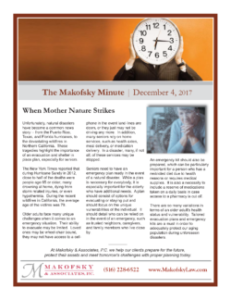 When Mother Nature Strikes
When Mother Nature Strikes
December 4, 2017
Unfortunately, natural disasters have become a common news story — from the Puerto Rico, Texas, and Florida hurricanes, to devastating wild fires in Northern California. These tragedies highlight the importance of an evacuation and shelter in place plan, especially for seniors.
The New York Times reported that during Hurricane Sandy in 2012, close to half of the deaths were people age 65 or older; many drowning at home, dying from storm related injuries, or even hypothermia. During the recent wildfires in California, the average age of the victims was 79.
Older adults face many unique challenges when it comes to an emergency situation. Their ability to evacuate may be limited. Loved ones may be wheel-chair bound, they may not have access to a cell phone in the event land-lines are down, or they may not be driving any more. In addition, many seniors rely on home services, such as health aides, meal delivery, or medication delivery. In a disaster, many, if not all, of these services may be stopped.
Seniors need to have an emergency plan ready in the event of a natural disaster. While a plan is necessary for everybody, it is especially important for the elderly who have additional needs. A plan should consist of options for evacuating or staying put and should focus on the unique vulnerabilities of the individual. It should detail who can be relied on in the event of an emergency, such as trusted neighbors, caregivers, and family members who live close by.
An emergency kit should be prepared, which can be particularly important for a person who has a restricted diet due to health reasons or requires medical supplies. It is also necessary to include a reserve of medications taken on a daily basis in case access to a pharmacy is cut off.
There are so many variations in terms of an older adult’s health status and vulnerability. Tailored evacuation plans and emergency kits are a must in order to protect our aging population during unforeseen disasters.


 When Mother Nature Strikes
When Mother Nature Strikes